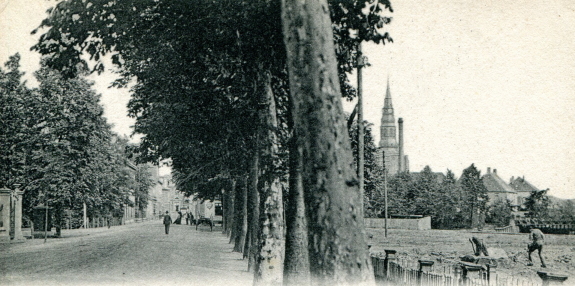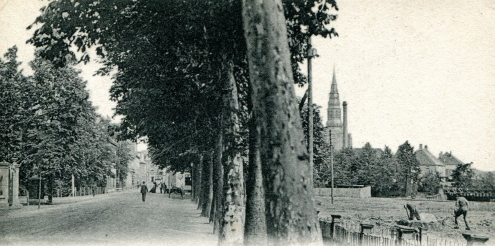Photo of the month - March 2023
The Westend - the development of a street
The historical photo of the month March 2023 shows a street that probably only a few Bocholters will recognise - even though quite a few drive along it almost every day: The Westend.
"We have in our town also a Westend!" - wrote a Bocholt resident in 1905 on a picture postcard he probably sent to an acquaintance in the British capital. He was projecting the similarity of the name with the London district "West End" in the City of Westminster. The map itself reproduced the common motif of the West End with a view of the street from the east, with the Villa Liebreich and the statue of the bridge saint Nepomuk at the corner with the Chaussee to Dinxperlo.
The "western end of the borough
The picture now available shows the rather unknown, namely the opposite view into the traffic route from the west towards the city around 1904. If the tower of St. George's Church and the lock bridge were not visible on the right, the viewer would probably be approaching the houses of the suburb rather disoriented.
The term "Westend" literally refers to the western end of the Bocholt district, where in the early days there were only very few buildings. This street lay outside the old soft area of the town, so it did not form an actual local street. In the old days, it was part of the existing Münster-Emmerich post road and belonged as a country road to the district of Borken, which built it in 1852 with a crown width of eight metres and ditches on both sides.
It was therefore a traffic route leading from one town to another, not a route serving traffic within the town of Bocholt. It therefore functioned as a communication route and remained so until it became the property of the province of Westphalia in 1913. When the canalisation of the city of Bocholt began in 1911, the Westend took up the main collector sewer.
From textile location to residential area
On 11 March 1915, the town council authorised Mayor Wesemann to conclude a contract with the Province of Westphalia, according to which the town of Bocholt was to build pavements and gutters along Westendstrasse. The paving of the roadway with small paving stones by the province and the laying of kerbs and levelled footpaths by the city of Bocholt took place in 1917/18.
In the meantime, several textile companies had settled on the Westend since the second half of the 19th century, including the firms of von Velsen, Danner & Dorweiler, Tangerding, Liebreich & Weinholt and later also the Flender engine factory. The Second World War completely changed the appearance of the street. Today, Westend, with its residential and commercial buildings, is one of the city's major arterial roads.




